人教版(2019)必修 第三册Unit 1 Festivals and Celebrations Reading for Writing教学设计(表格式)
文档属性
| 名称 | 人教版(2019)必修 第三册Unit 1 Festivals and Celebrations Reading for Writing教学设计(表格式) |
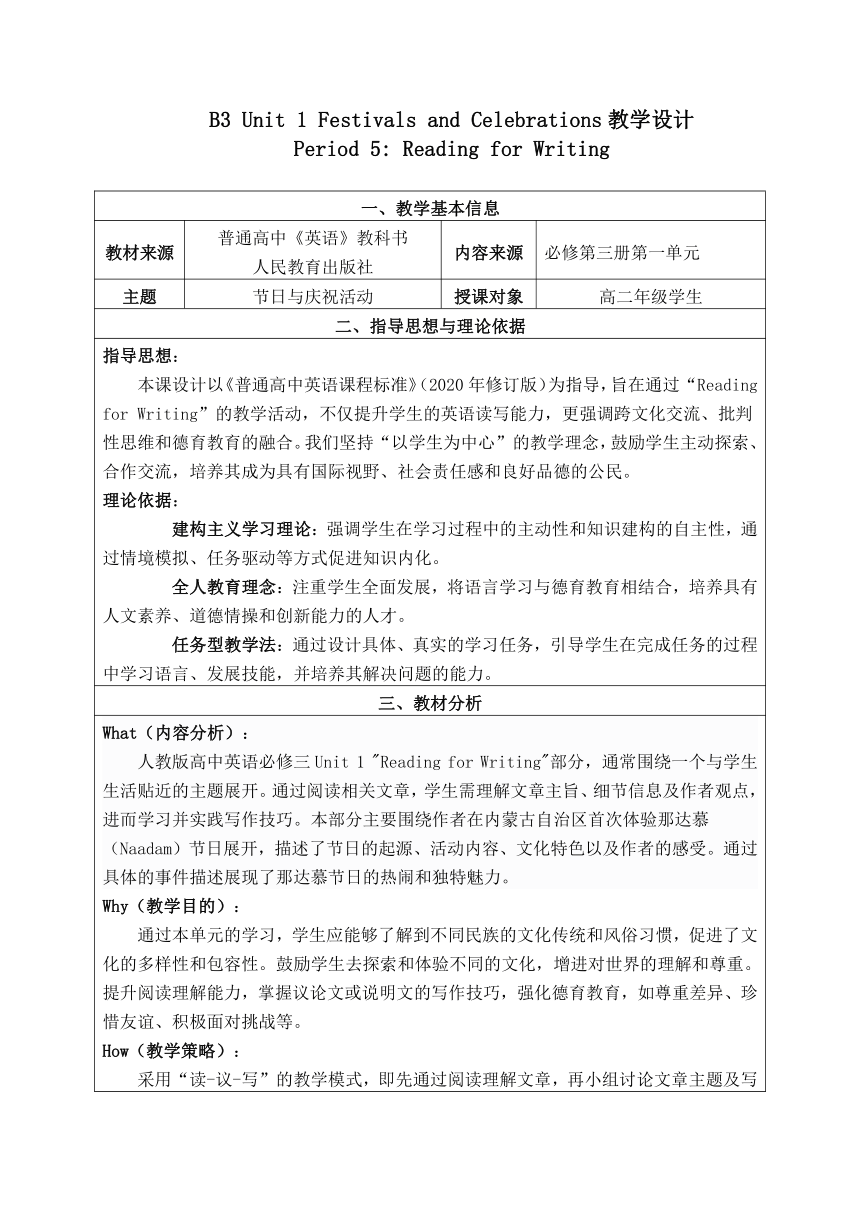
|
|
| 格式 | doc | ||
| 文件大小 | 95.0KB | ||
| 资源类型 | 教案 | ||
| 版本资源 | 人教版(2019) | ||
| 科目 | 英语 | ||
| 更新时间 | 2024-09-21 10:18:29 | ||
图片预览

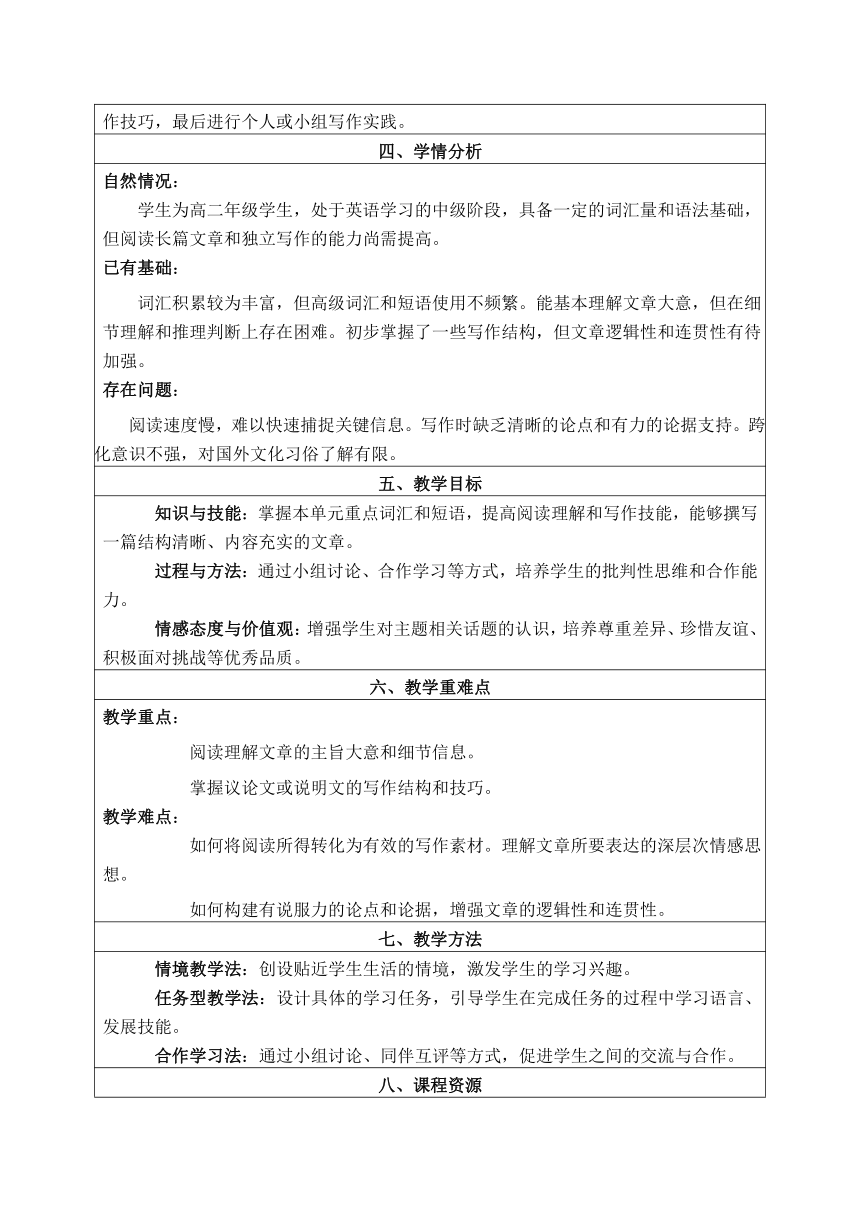
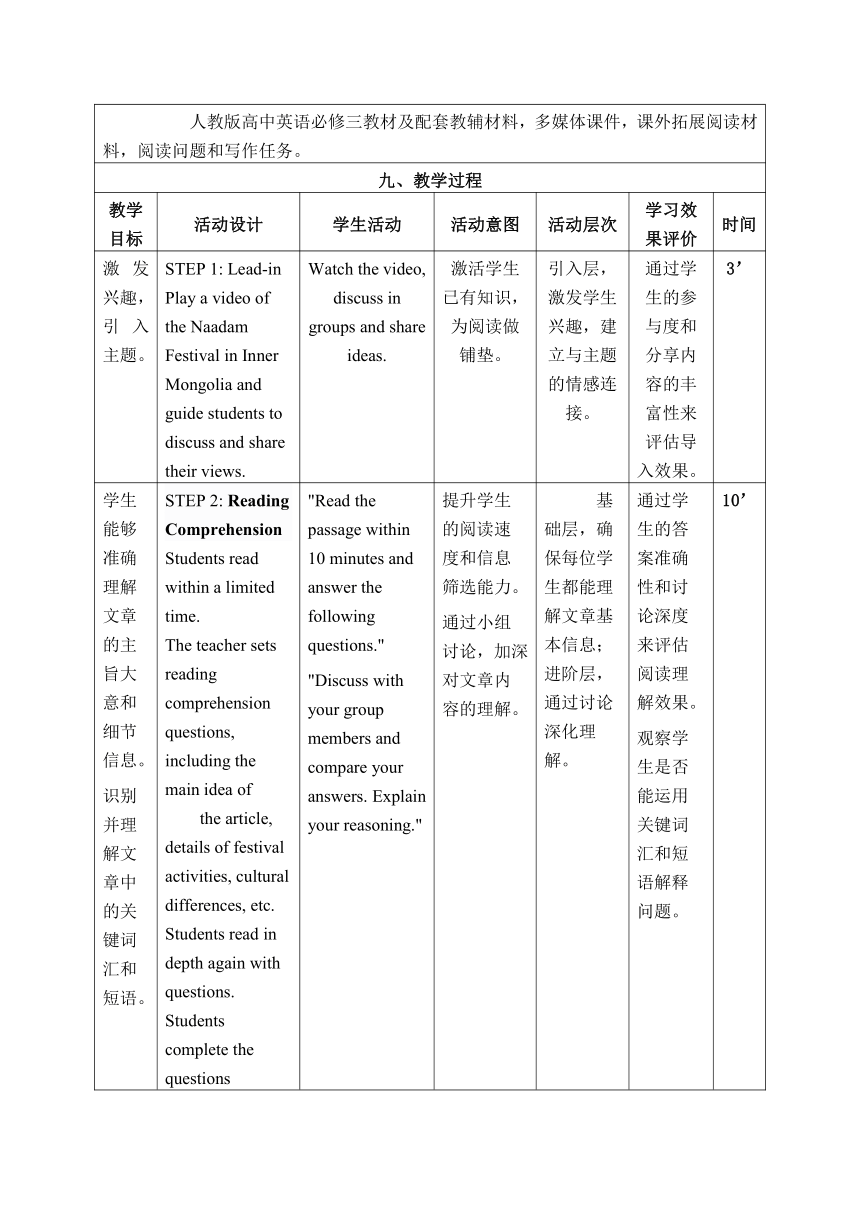
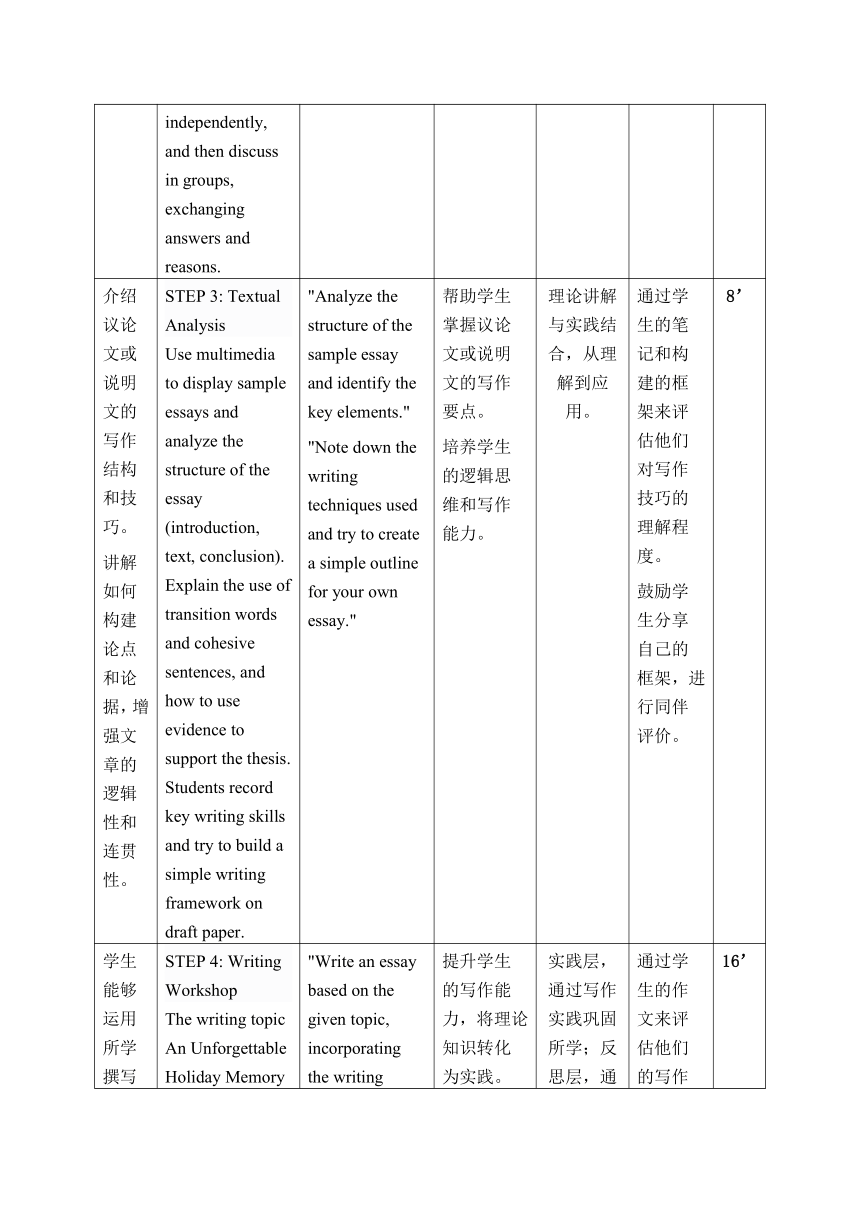
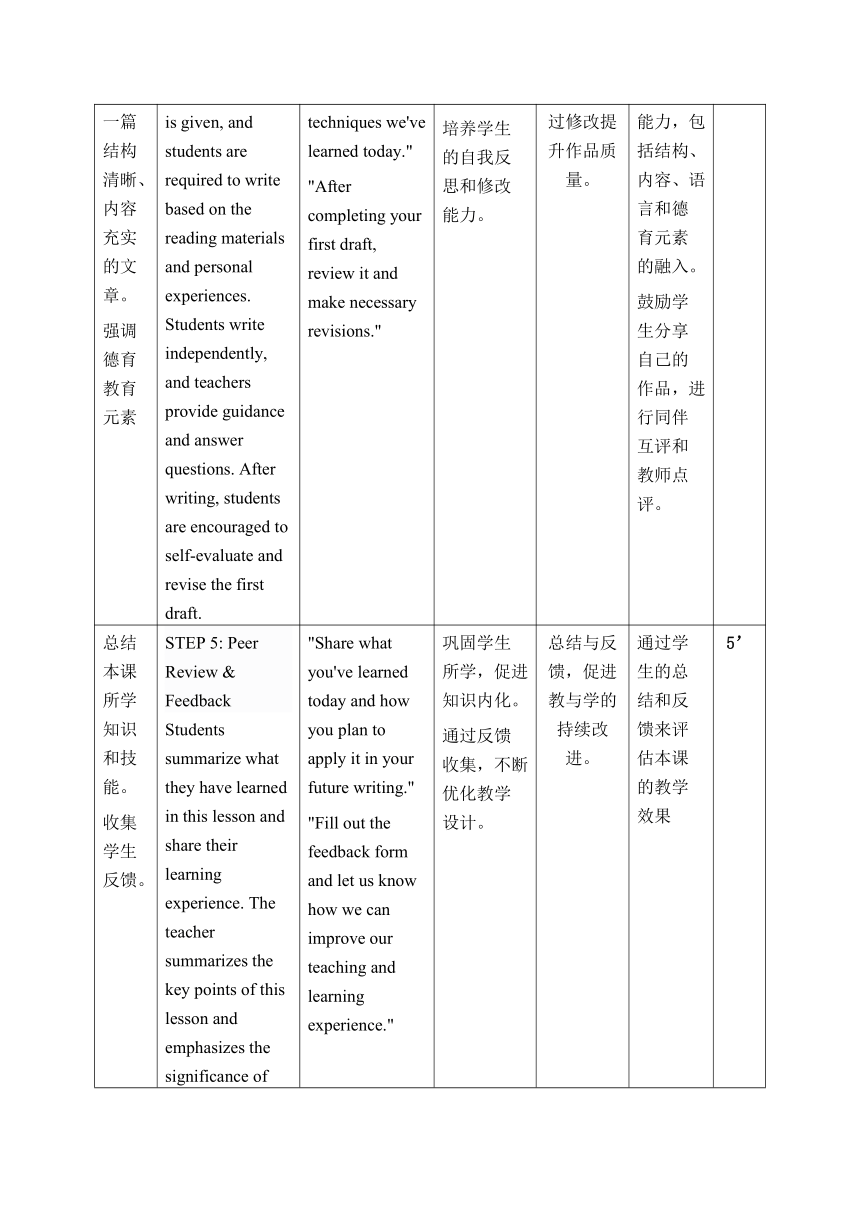
文档简介
B3 Unit 1 Festivals and Celebrations教学设计
Period 5: Reading for Writing
一、教学基本信息
教材来源 普通高中《英语》教科书人民教育出版社 内容来源 必修第三册第一单元
主题 节日与庆祝活动 授课对象 高二年级学生
二、指导思想与理论依据
指导思想:本课设计以《普通高中英语课程标准》(2020年修订版)为指导,旨在通过“Reading for Writing”的教学活动,不仅提升学生的英语读写能力,更强调跨文化交流、批判性思维和德育教育的融合。我们坚持“以学生为中心”的教学理念,鼓励学生主动探索、合作交流,培养其成为具有国际视野、社会责任感和良好品德的公民。理论依据: 建构主义学习理论:强调学生在学习过程中的主动性和知识建构的自主性,通过情境模拟、任务驱动等方式促进知识内化。 全人教育理念:注重学生全面发展,将语言学习与德育教育相结合,培养具有人文素养、道德情操和创新能力的人才。 任务型教学法:通过设计具体、真实的学习任务,引导学生在完成任务的过程中学习语言、发展技能,并培养其解决问题的能力。
三、教材分析
What(内容分析):人教版高中英语必修三Unit 1 "Reading for Writing"部分,通常围绕一个与学生生活贴近的主题展开。通过阅读相关文章,学生需理解文章主旨、细节信息及作者观点,进而学习并实践写作技巧。本部分主要围绕作者在内蒙古自治区首次体验那达慕(Naadam)节日展开,描述了节日的起源、活动内容、文化特色以及作者的感受。通过具体的事件描述展现了那达慕节日的热闹和独特魅力。Why(教学目的):通过本单元的学习,学生应能够了解到不同民族的文化传统和风俗习惯,促进了文化的多样性和包容性。鼓励学生去探索和体验不同的文化,增进对世界的理解和尊重。提升阅读理解能力,掌握议论文或说明文的写作技巧,强化德育教育,如尊重差异、珍惜友谊、积极面对挑战等。How(教学策略):采用“读-议-写”的教学模式,即先通过阅读理解文章,再小组讨论文章主题及写作技巧,最后进行个人或小组写作实践。
四、学情分析
自然情况:学生为高二年级学生,处于英语学习的中级阶段,具备一定的词汇量和语法基础,但阅读长篇文章和独立写作的能力尚需提高。已有基础:词汇积累较为丰富,但高级词汇和短语使用不频繁。能基本理解文章大意,但在细节理解和推理判断上存在困难。初步掌握了一些写作结构,但文章逻辑性和连贯性有待加强。存在问题:阅读速度慢,难以快速捕捉关键信息。写作时缺乏清晰的论点和有力的论据支持。跨文化意识不强,对国外文化习俗了解有限。
五、教学目标
知识与技能:掌握本单元重点词汇和短语,提高阅读理解和写作技能,能够撰写一篇结构清晰、内容充实的文章。过程与方法:通过小组讨论、合作学习等方式,培养学生的批判性思维和合作能力。情感态度与价值观:增强学生对主题相关话题的认识,培养尊重差异、珍惜友谊、积极面对挑战等优秀品质。
六、教学重难点
教学重点: 阅读理解文章的主旨大意和细节信息。 掌握议论文或说明文的写作结构和技巧。教学难点: 如何将阅读所得转化为有效的写作素材。理解文章所要表达的深层次情感思想。 如何构建有说服力的论点和论据,增强文章的逻辑性和连贯性。
七、教学方法
情境教学法:创设贴近学生生活的情境,激发学生的学习兴趣。任务型教学法:设计具体的学习任务,引导学生在完成任务的过程中学习语言、发展技能。合作学习法:通过小组讨论、同伴互评等方式,促进学生之间的交流与合作。
八、课程资源
人教版高中英语必修三教材及配套教辅材料,多媒体课件,课外拓展阅读材料,阅读问题和写作任务。
九、教学过程
教学目标 活动设计 学生活动 活动意图 活动层次 学习效果评价 时间
激发兴趣,引入主题。 STEP 1: Lead-inPlay a video of the Naadam Festival in Inner Mongolia and guide students to discuss and share their views. Watch the video, discuss in groups and share ideas. 激活学生已有知识,为阅读做铺垫。 引入层,激发学生兴趣,建立与主题的情感连接。 通过学生的参与度和分享内容的丰富性来评估导入效果。 3’
学生能够准确理解文章的主旨大意和细节信息。识别并理解文章中的关键词汇和短语。 STEP 2: Reading ComprehensionStudents read within a limited time. The teacher sets reading comprehension questions, including the main idea of the article, details of festival activities, cultural differences, etc. Students read in depth again with questions. Students complete the questions independently, and then discuss in groups, exchanging answers and reasons. "Read the passage within 10 minutes and answer the following questions.""Discuss with your group members and compare your answers. Explain your reasoning." 提升学生的阅读速度和信息筛选能力。通过小组讨论,加深对文章内容的理解。 基础层,确保每位学生都能理解文章基本信息;进阶层,通过讨论深化理解。 通过学生的答案准确性和讨论深度来评估阅读理解效果。观察学生是否能运用关键词汇和短语解释问题。 10’
介绍议论文或说明文的写作结构和技巧。讲解如何构建论点和论据,增强文章的逻辑性和连贯性。 STEP 3: Textual AnalysisUse multimedia to display sample essays and analyze the structure of the essay (introduction, text, conclusion). Explain the use of transition words and cohesive sentences, and how to use evidence to support the thesis. Students record key writing skills and try to build a simple writing framework on draft paper. "Analyze the structure of the sample essay and identify the key elements.""Note down the writing techniques used and try to create a simple outline for your own essay." 帮助学生掌握议论文或说明文的写作要点。培养学生的逻辑思维和写作能力。 理论讲解与实践结合,从理解到应用。 通过学生的笔记和构建的框架来评估他们对写作技巧的理解程度。鼓励学生分享自己的框架,进行同伴评价。 8’
学生能够运用所学撰写一篇结构清晰、内容充实的文章。强调德育教育元素 STEP 4: Writing WorkshopThe writing topic An Unforgettable Holiday Memory is given, and students are required to write based on the reading materials and personal experiences. Students write independently, and teachers provide guidance and answer questions. After writing, students are encouraged to self-evaluate and revise the first draft. "Write an essay based on the given topic, incorporating the writing techniques we've learned today.""After completing your first draft, review it and make necessary revisions." 提升学生的写作能力,将理论知识转化为实践。培养学生的自我反思和修改能力。 实践层,通过写作实践巩固所学;反思层,通过修改提升作品质量。 通过学生的作文来评估他们的写作能力,包括结构、内容、语言和德育元素的融入。鼓励学生分享自己的作品,进行同伴互评和教师点评。 16’
总结本课所学知识和技能。收集学生反馈。 STEP 5: Peer Review & FeedbackStudents summarize what they have learned in this lesson and share their learning experience. The teacher summarizes the key points of this lesson and emphasizes the significance of Feedback forms are distributed to collect students’ opinions and suggestions on teaching activities. "Share what you've learned today and how you plan to apply it in your future writing.""Fill out the feedback form and let us know how we can improve our teaching and learning experience." 巩固学生所学,促进知识内化。通过反馈收集,不断优化教学设计。 总结与反馈,促进教与学的持续改进。 通过学生的总结和反馈来评估本课的教学效果 5’
巩固和拓展课堂所学知识。 STEP 6: Wrap-up & Homework Assign homework that is closely related to the content of this lesson, such as revising and improving essays, reading English articles on related topics and writing book reviews, etc. "For homework, please revise your essay and make sure it meets the requirements we discussed in class. Additionally, read the attached article and prepare a brief reflection on it." 通过作业巩固学生的写作能力和阅读理解能力。 课后延伸与预习引导,促进学习的连续性和自主性。 通过作业完成情况来评估学生对课堂内容的掌握程度和应用能力。 3’
十、板书设计
中心板块 Reading and writing skills 左侧板块1、Reading comprehension Main ideaUnderstanding of detailsReasoning右侧板块2、Writing SkillsArgumentative/Explanatory Essay Structurea. Introductionb. Text(View and evidence)c. ConclusionTransition words and linking sentencesRespect differences and cherish friendshipHomework:Writing Practice Topics:Introduce a Festival.Finish the comprehensive practical work.假设你是李华,你的美国笔友 John 对于中国的元宵节感到好奇,请回复 John 一封 email,内容包括:1. 元宵节的起源(起源于汉朝,始于皇帝祭祀天上的神仙)2. 元宵节的主要习俗(吃汤圆,赏花灯,猜灯谜等)3. 邀请 John 来中国亲自体会元宵节。参考词汇:1.元宵节:The Lantern Festival2.汤圆:glutinous rice balls3.花灯展:lantern shows 4.猜灯谜:guess riddles on hanging lanterns Dear John, Yours, Lihua人教版(2019)Unit 1 Festivals & Celebrations综合实践作业Step 1 Assignment of the activity中国传统节日食品及配方Step 2 Goals of the activity1)通过该活动让学生知道中华民族重要的传统节日及日期,了解人们庆祝传统节日的民间习俗;2)通过收集、整理、研究等活动,培养学生的生活情趣,使学生热爱生活,热爱中华民族。3)传承中华美食,增强民族自信心和自豪感。4)本活动还可以培养团队协作的能力与意识。Step 3 Design of the activity将全班学生分成四组,每个小组分别负责收集春节、元宵节、端午节和中秋节的代表食品,并通过网络等渠道搜集其不同地域的配方。Step 4 Approaches of the activityGroup No.Festival & its typical foodsRecipeNotes1234Step 5 Guidance of the activity教师给每组学生明确任务,让小组成员讨论之后做出具体分工。Step 6 Proceed of the activity1)布置任务,明确活动目的、提交研究成果时间等;2)学生可以通过各种渠道收集信息,如餐馆,网络或请教厨师等;3)将整理好的材料归纳总结,最后以英语报告的形式在课堂上展示Step 7 Presentation of the activity每个小组分别派一名代表在讲台上通过制作的PPT课件来展示节日文化,节日食品配方或制作过程。Step 8 Evaluation & Feedbacks (Tick the relevant option)Group OneGroup TwoGroup ThreeGroup Four□Not a bit satisfied□Not satisfied□Satisfied□A little satisfied□Very satisfied□Not a bit satisfied□Not satisfied□Satisfied□A little satisfied□Very satisfied□Not a bit satisfied□Not satisfied□Satisfied□A little satisfied□Very satisfied□Not a bit satisfied□Not satisfied□Satisfied□A little satisfied□Very satisfied
十一、教学反思
多媒体辅助教学:利用多媒体展示范文和讲解写作技巧,使教学内容更加直观生动,有助于学生理解和记忆。 小组讨论:通过小组讨论,学生之间的交流与合作增多,有助于相互学习和借鉴,同时也培养了学生的团队合作精神。 实践与反思:写作实践环节让学生将理论知识转化为实际能力,而写作后的自我评价和修改则培养了学生的反思能力。由于班级人数较多,教师在巡回指导时难以兼顾到每位学生。未来可以考虑采用小组合作学习的方式,让组内成员相互帮助和指导,同时教师也对个别需要帮助的学生进行重点辅导。 作业反馈:作业批改和反馈是检验学生学习效果的重要环节。未来需要更加及时地批改作业,并给予具体、有针对性的反馈,以帮助学生更好地掌握所学知识。
十二、评价设计
Checklist
Items Excellent Good So-so Undesirable
1.Understand the Cultural Significance of Festivals
2.Recognize Diverse Customs and Traditions
3.Analyze Descriptive Writing Techniques
4.Develop Vocabulary Related to Festivals and Cultural Events
5.Write a Personal Narrative About a Cultural Experience
6.Understand the organization and language features.
写作话题:
Period 5: Reading for Writing
一、教学基本信息
教材来源 普通高中《英语》教科书人民教育出版社 内容来源 必修第三册第一单元
主题 节日与庆祝活动 授课对象 高二年级学生
二、指导思想与理论依据
指导思想:本课设计以《普通高中英语课程标准》(2020年修订版)为指导,旨在通过“Reading for Writing”的教学活动,不仅提升学生的英语读写能力,更强调跨文化交流、批判性思维和德育教育的融合。我们坚持“以学生为中心”的教学理念,鼓励学生主动探索、合作交流,培养其成为具有国际视野、社会责任感和良好品德的公民。理论依据: 建构主义学习理论:强调学生在学习过程中的主动性和知识建构的自主性,通过情境模拟、任务驱动等方式促进知识内化。 全人教育理念:注重学生全面发展,将语言学习与德育教育相结合,培养具有人文素养、道德情操和创新能力的人才。 任务型教学法:通过设计具体、真实的学习任务,引导学生在完成任务的过程中学习语言、发展技能,并培养其解决问题的能力。
三、教材分析
What(内容分析):人教版高中英语必修三Unit 1 "Reading for Writing"部分,通常围绕一个与学生生活贴近的主题展开。通过阅读相关文章,学生需理解文章主旨、细节信息及作者观点,进而学习并实践写作技巧。本部分主要围绕作者在内蒙古自治区首次体验那达慕(Naadam)节日展开,描述了节日的起源、活动内容、文化特色以及作者的感受。通过具体的事件描述展现了那达慕节日的热闹和独特魅力。Why(教学目的):通过本单元的学习,学生应能够了解到不同民族的文化传统和风俗习惯,促进了文化的多样性和包容性。鼓励学生去探索和体验不同的文化,增进对世界的理解和尊重。提升阅读理解能力,掌握议论文或说明文的写作技巧,强化德育教育,如尊重差异、珍惜友谊、积极面对挑战等。How(教学策略):采用“读-议-写”的教学模式,即先通过阅读理解文章,再小组讨论文章主题及写作技巧,最后进行个人或小组写作实践。
四、学情分析
自然情况:学生为高二年级学生,处于英语学习的中级阶段,具备一定的词汇量和语法基础,但阅读长篇文章和独立写作的能力尚需提高。已有基础:词汇积累较为丰富,但高级词汇和短语使用不频繁。能基本理解文章大意,但在细节理解和推理判断上存在困难。初步掌握了一些写作结构,但文章逻辑性和连贯性有待加强。存在问题:阅读速度慢,难以快速捕捉关键信息。写作时缺乏清晰的论点和有力的论据支持。跨文化意识不强,对国外文化习俗了解有限。
五、教学目标
知识与技能:掌握本单元重点词汇和短语,提高阅读理解和写作技能,能够撰写一篇结构清晰、内容充实的文章。过程与方法:通过小组讨论、合作学习等方式,培养学生的批判性思维和合作能力。情感态度与价值观:增强学生对主题相关话题的认识,培养尊重差异、珍惜友谊、积极面对挑战等优秀品质。
六、教学重难点
教学重点: 阅读理解文章的主旨大意和细节信息。 掌握议论文或说明文的写作结构和技巧。教学难点: 如何将阅读所得转化为有效的写作素材。理解文章所要表达的深层次情感思想。 如何构建有说服力的论点和论据,增强文章的逻辑性和连贯性。
七、教学方法
情境教学法:创设贴近学生生活的情境,激发学生的学习兴趣。任务型教学法:设计具体的学习任务,引导学生在完成任务的过程中学习语言、发展技能。合作学习法:通过小组讨论、同伴互评等方式,促进学生之间的交流与合作。
八、课程资源
人教版高中英语必修三教材及配套教辅材料,多媒体课件,课外拓展阅读材料,阅读问题和写作任务。
九、教学过程
教学目标 活动设计 学生活动 活动意图 活动层次 学习效果评价 时间
激发兴趣,引入主题。 STEP 1: Lead-inPlay a video of the Naadam Festival in Inner Mongolia and guide students to discuss and share their views. Watch the video, discuss in groups and share ideas. 激活学生已有知识,为阅读做铺垫。 引入层,激发学生兴趣,建立与主题的情感连接。 通过学生的参与度和分享内容的丰富性来评估导入效果。 3’
学生能够准确理解文章的主旨大意和细节信息。识别并理解文章中的关键词汇和短语。 STEP 2: Reading ComprehensionStudents read within a limited time. The teacher sets reading comprehension questions, including the main idea of the article, details of festival activities, cultural differences, etc. Students read in depth again with questions. Students complete the questions independently, and then discuss in groups, exchanging answers and reasons. "Read the passage within 10 minutes and answer the following questions.""Discuss with your group members and compare your answers. Explain your reasoning." 提升学生的阅读速度和信息筛选能力。通过小组讨论,加深对文章内容的理解。 基础层,确保每位学生都能理解文章基本信息;进阶层,通过讨论深化理解。 通过学生的答案准确性和讨论深度来评估阅读理解效果。观察学生是否能运用关键词汇和短语解释问题。 10’
介绍议论文或说明文的写作结构和技巧。讲解如何构建论点和论据,增强文章的逻辑性和连贯性。 STEP 3: Textual AnalysisUse multimedia to display sample essays and analyze the structure of the essay (introduction, text, conclusion). Explain the use of transition words and cohesive sentences, and how to use evidence to support the thesis. Students record key writing skills and try to build a simple writing framework on draft paper. "Analyze the structure of the sample essay and identify the key elements.""Note down the writing techniques used and try to create a simple outline for your own essay." 帮助学生掌握议论文或说明文的写作要点。培养学生的逻辑思维和写作能力。 理论讲解与实践结合,从理解到应用。 通过学生的笔记和构建的框架来评估他们对写作技巧的理解程度。鼓励学生分享自己的框架,进行同伴评价。 8’
学生能够运用所学撰写一篇结构清晰、内容充实的文章。强调德育教育元素 STEP 4: Writing WorkshopThe writing topic An Unforgettable Holiday Memory is given, and students are required to write based on the reading materials and personal experiences. Students write independently, and teachers provide guidance and answer questions. After writing, students are encouraged to self-evaluate and revise the first draft. "Write an essay based on the given topic, incorporating the writing techniques we've learned today.""After completing your first draft, review it and make necessary revisions." 提升学生的写作能力,将理论知识转化为实践。培养学生的自我反思和修改能力。 实践层,通过写作实践巩固所学;反思层,通过修改提升作品质量。 通过学生的作文来评估他们的写作能力,包括结构、内容、语言和德育元素的融入。鼓励学生分享自己的作品,进行同伴互评和教师点评。 16’
总结本课所学知识和技能。收集学生反馈。 STEP 5: Peer Review & FeedbackStudents summarize what they have learned in this lesson and share their learning experience. The teacher summarizes the key points of this lesson and emphasizes the significance of Feedback forms are distributed to collect students’ opinions and suggestions on teaching activities. "Share what you've learned today and how you plan to apply it in your future writing.""Fill out the feedback form and let us know how we can improve our teaching and learning experience." 巩固学生所学,促进知识内化。通过反馈收集,不断优化教学设计。 总结与反馈,促进教与学的持续改进。 通过学生的总结和反馈来评估本课的教学效果 5’
巩固和拓展课堂所学知识。 STEP 6: Wrap-up & Homework Assign homework that is closely related to the content of this lesson, such as revising and improving essays, reading English articles on related topics and writing book reviews, etc. "For homework, please revise your essay and make sure it meets the requirements we discussed in class. Additionally, read the attached article and prepare a brief reflection on it." 通过作业巩固学生的写作能力和阅读理解能力。 课后延伸与预习引导,促进学习的连续性和自主性。 通过作业完成情况来评估学生对课堂内容的掌握程度和应用能力。 3’
十、板书设计
中心板块 Reading and writing skills 左侧板块1、Reading comprehension Main ideaUnderstanding of detailsReasoning右侧板块2、Writing SkillsArgumentative/Explanatory Essay Structurea. Introductionb. Text(View and evidence)c. ConclusionTransition words and linking sentencesRespect differences and cherish friendshipHomework:Writing Practice Topics:Introduce a Festival.Finish the comprehensive practical work.假设你是李华,你的美国笔友 John 对于中国的元宵节感到好奇,请回复 John 一封 email,内容包括:1. 元宵节的起源(起源于汉朝,始于皇帝祭祀天上的神仙)2. 元宵节的主要习俗(吃汤圆,赏花灯,猜灯谜等)3. 邀请 John 来中国亲自体会元宵节。参考词汇:1.元宵节:The Lantern Festival2.汤圆:glutinous rice balls3.花灯展:lantern shows 4.猜灯谜:guess riddles on hanging lanterns Dear John, Yours, Lihua人教版(2019)Unit 1 Festivals & Celebrations综合实践作业Step 1 Assignment of the activity中国传统节日食品及配方Step 2 Goals of the activity1)通过该活动让学生知道中华民族重要的传统节日及日期,了解人们庆祝传统节日的民间习俗;2)通过收集、整理、研究等活动,培养学生的生活情趣,使学生热爱生活,热爱中华民族。3)传承中华美食,增强民族自信心和自豪感。4)本活动还可以培养团队协作的能力与意识。Step 3 Design of the activity将全班学生分成四组,每个小组分别负责收集春节、元宵节、端午节和中秋节的代表食品,并通过网络等渠道搜集其不同地域的配方。Step 4 Approaches of the activityGroup No.Festival & its typical foodsRecipeNotes1234Step 5 Guidance of the activity教师给每组学生明确任务,让小组成员讨论之后做出具体分工。Step 6 Proceed of the activity1)布置任务,明确活动目的、提交研究成果时间等;2)学生可以通过各种渠道收集信息,如餐馆,网络或请教厨师等;3)将整理好的材料归纳总结,最后以英语报告的形式在课堂上展示Step 7 Presentation of the activity每个小组分别派一名代表在讲台上通过制作的PPT课件来展示节日文化,节日食品配方或制作过程。Step 8 Evaluation & Feedbacks (Tick the relevant option)Group OneGroup TwoGroup ThreeGroup Four□Not a bit satisfied□Not satisfied□Satisfied□A little satisfied□Very satisfied□Not a bit satisfied□Not satisfied□Satisfied□A little satisfied□Very satisfied□Not a bit satisfied□Not satisfied□Satisfied□A little satisfied□Very satisfied□Not a bit satisfied□Not satisfied□Satisfied□A little satisfied□Very satisfied
十一、教学反思
多媒体辅助教学:利用多媒体展示范文和讲解写作技巧,使教学内容更加直观生动,有助于学生理解和记忆。 小组讨论:通过小组讨论,学生之间的交流与合作增多,有助于相互学习和借鉴,同时也培养了学生的团队合作精神。 实践与反思:写作实践环节让学生将理论知识转化为实际能力,而写作后的自我评价和修改则培养了学生的反思能力。由于班级人数较多,教师在巡回指导时难以兼顾到每位学生。未来可以考虑采用小组合作学习的方式,让组内成员相互帮助和指导,同时教师也对个别需要帮助的学生进行重点辅导。 作业反馈:作业批改和反馈是检验学生学习效果的重要环节。未来需要更加及时地批改作业,并给予具体、有针对性的反馈,以帮助学生更好地掌握所学知识。
十二、评价设计
Checklist
Items Excellent Good So-so Undesirable
1.Understand the Cultural Significance of Festivals
2.Recognize Diverse Customs and Traditions
3.Analyze Descriptive Writing Techniques
4.Develop Vocabulary Related to Festivals and Cultural Events
5.Write a Personal Narrative About a Cultural Experience
6.Understand the organization and language features.
写作话题:
